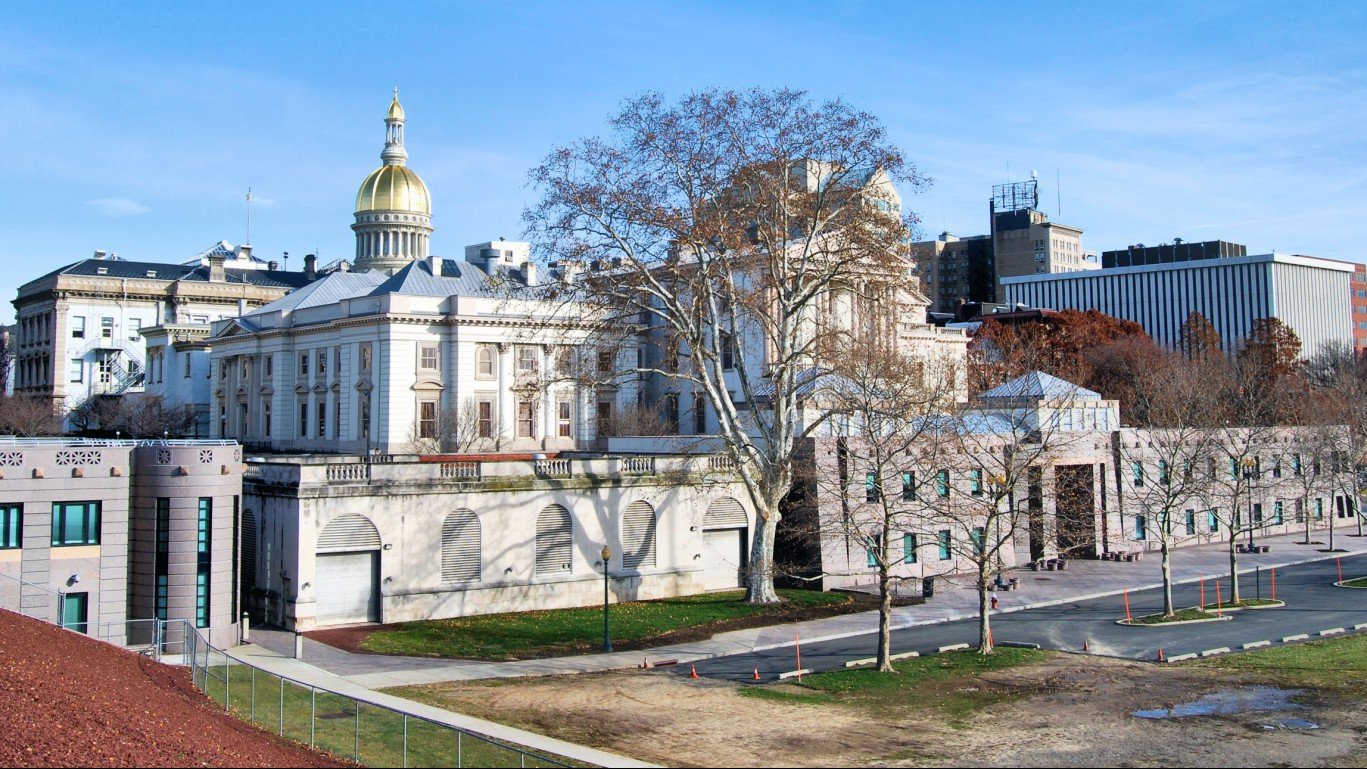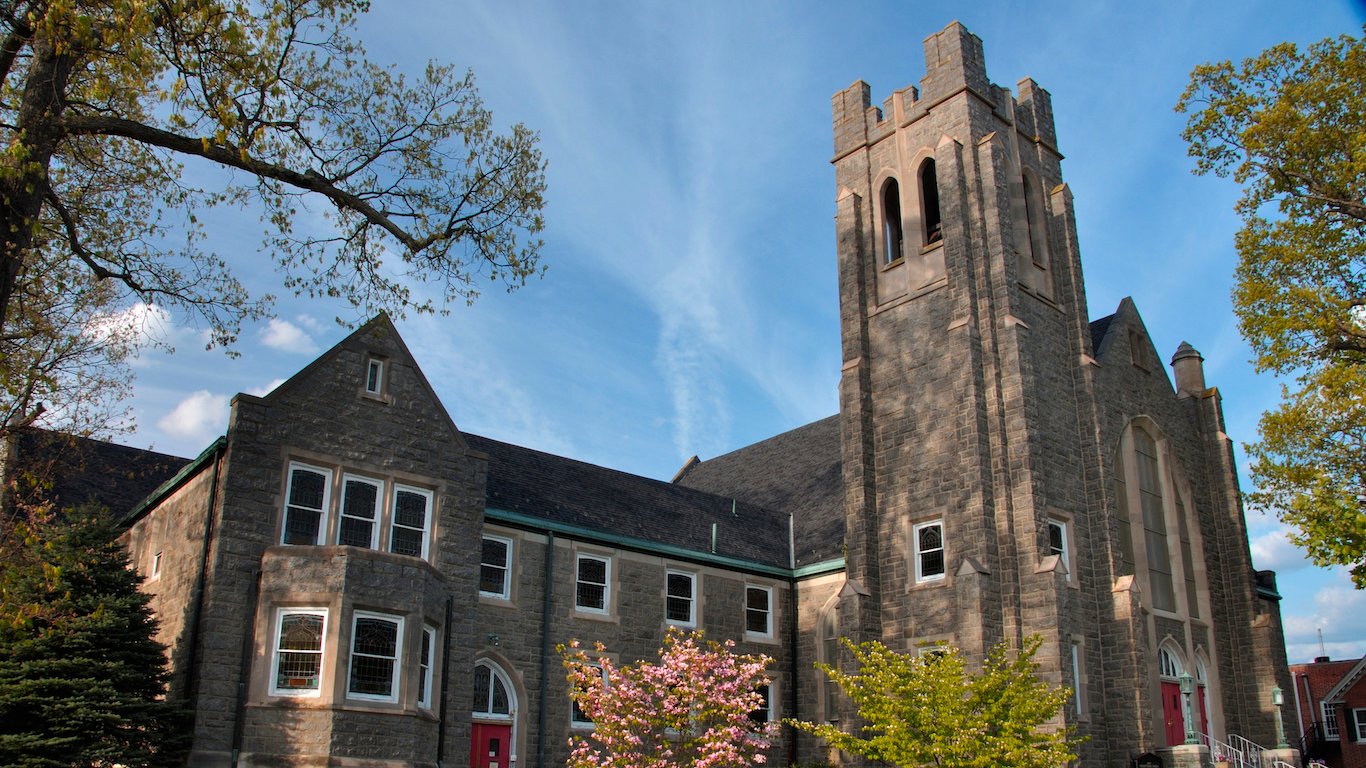Special Report
15 Cities Where Unions Are Disappearing

Published:
Last Updated:

Union membership surged in the United States in the wake of the Great Depression and WWII. Organized labor peaked in the mid-1950s, when 35% of the workforce belonged to a labor union. Since then, union membership has declined and the power of organized labor has weakened considerably. Today, only 10.7% of U.S. workers are unionized.
While labor union participation has been declining for decades, the decline has been especially dramatic in some parts of the country in the last 10 years. Cities like Detroit, Michigan and Youngstown, Ohio are nowhere near the strongholds of organized labor they once were.
In many of these cities, the decline of once dominant industries partially explains reduced union membership. In other areas, state laws that discourage collective bargaining have led to less participation in organized labor.
24/7 Wall St. reviewed 10-year changes in union membership to identify the cities where unions are disappearing. Of the 200 metropolitan areas reviewed, 15 cities reported a more than 7.5 percentage point decline in union participation between 2006 and 2016. For reference, 10.7% of the U.S. workforce is part of a union today, compared to 12% in 2006.
Click here to see the cities where unions are disappearing.
Click here to see our detailed findings and methodology.

15. Detroit-Warren-Dearborn, MI
> Unionized workers 2006: 21.8%
> Unionized workers 2016: 14.0%
> 10 yr. workforce change: -51,985 (-2.7%)
> Industry shedding the most jobs: Manufacturing
The birthplace of the moving assembly line, Detroit was once a manufacturing powerhouse. Today, the Detroit metro area is a shadow of its former self. Increased automation of industrial operations and availability of cheap labor abroad have decimated the area’s manufacturing industry, which was once home some of the nation’s largest and most powerful labor unions.
In the last 10 years, union membership declined from 21.8% of the workforce to 14.0%, a 7.8 percentage point decline — the 15th steepest drop among U.S. metro areas and about seven times the decline nationwide.
[in-text-ad]

14. Canton-Massillon, OH
> Unionized workers 2006: 19.6%
> Unionized workers 2016: 11.6%
> 10 yr. workforce change: +12,647 (+6.9%)
> Industry shedding the most jobs: Manufacturing
Union membership in the Canton-Massillon, Ohio metro area dropped from 19.6% of the workforce in 2006 to just 11.6% of the workforce in 2016. Public sector employees are more likely to belong to a labor union than private sector workers. As is generally the case in cities with shrinking labor unions, a shrinking public workforce partially explains declining union membership in the Canton-Massillon metro area. The number of public sector workers fell by 30.1% between 2006 and 2016. Meanwhile, private sector employment climbed 13.5%.

13. Harrisburg-Carlisle, PA
> Unionized workers 2006: 17.8%
> Unionized workers 2016: 9.5%
> 10 yr. workforce change: +5,813 (+2.3%)
> Industry shedding the most jobs: Wholesale trade
The number of unionized workers in the Harrisburg metro area fell from about 45,300 in 2006 to only about 25,000 in 2016. Once a union stronghold, some 17.8% of the area’s workforce belonged to a union in 2006, well above the 12.0% share nationwide at the time. As of 2016, only 9.5% of the metro area workforce belonged to a union, a slightly smaller share than the 10.7% share of workers nationwide.
Union membership declines in the private sector accounted for most of the drop in Harrisburg-Carlisle. Union membership in the private sector declined by 50% in the last 10 years, even as total private sector employment climbed by 5.6%.

12. Cape Coral-Fort Myers, FL
> Unionized workers 2006: 10.8%
> Unionized workers 2016: 2.4%
> 10 yr. workforce change: +30,821 (+15.6%)
> Industry shedding the most jobs: Construction
In 1943, Florida became the first state in the country to pass right-to-work laws, which usually prohibit unions and employers from entering into agreements such as employing only union members. Partially because Florida has been a right-to-work state for so long, private sector union membership is virtually non-existent in the Cape Coral-Fort Myers metro area. Only 1.2% of private sector workers are unionized, the same share as in 2006. The metro area’s 8.4 percentage point 10-year union membership decline was entirely in the public sector. In 2006, 60.8% of the public sector labor force were in a union. As of last year, only 12.4% of the metro area’s public sector workers were unionized.
[in-text-ad-2]

11. Amarillo, TX
> Unionized workers 2006: 10.1%
> Unionized workers 2016: 1.7%
> 10 yr. workforce change: +4,908 (+4.0%)
> Industry shedding the most jobs: Manufacturing
Manufacturing is one of the industries most likely to have unionized workers. In the face of increased reliance on automation and cheap labor abroad, the manufacturing industry has been shrinking in the United States. In the last 10 years the Amarillo metro area has shed some 1,800 manufacturing jobs, even as the overall metro area workforce netted nearly 5,000 new workers over the same period.
The shrinking manufacturing base likely contributed to the decline in overall union membership in Amarillo. Union membership in the area’s private sector, which includes manufacturing, totalled over 6,000 in 2006. Today, it has all but vanished.

10. Deltona-Daytona Beach-Ormond Beach, FL
> Unionized workers 2006: 12.8%
> Unionized workers 2016: 4.1%
> 10 yr. workforce change: +26,263 (+14.7%)
> Industry shedding the most jobs: Construction
As recently as 10 years ago, over half of all public sector workers in the Daytona Beach metro area were unionized. Today, fewer than 1 in 5 belong to a union. The decline in public sector organized labor largely explains the 8.7 point decline in the percentage of area workers with union membership in the last decade. With less than 3% participation, private sector union membership has been relatively insignificant in the metro area for at least the last 10 years.
The declining union membership in the metro area’s public sector is likely also attributable to a shrinking workforce. In 2006, there were 38,500 public workers in the area. As of 2016, there were only about 27,400.
[in-text-ad]

9. Youngstown-Warren-Boardman, OH-PA
> Unionized workers 2006: 24.1%
> Unionized workers 2016: 15.1%
> 10 yr. workforce change: +13,224 (+7.3%)
> Industry shedding the most jobs: Manufacturing
Workers in the manufacturing industry are among the most likely to be unionized. The Youngstown-Warren-Boardman metro area shed nearly 12,000 manufacturing jobs in the last decade, more than any other industry. The decline likely contributed to a reduction of 14,000 union members over the same period.
Pennsylvania and Ohio are not right-to-work states, and despite declining union membership, organized labor still has a relatively strong presence in the area. Some 15.1% of Youngstown-Warren-Boardman metro area’s workers belong to a union — well above the 10.7% share of the U.S. labor force.

8. Oshkosh-Neenah, WI
> Unionized workers 2006: 16.7%
> Unionized workers 2016: 7.5%
> 10 yr. workforce change: +24,504 (+35.2%)
> Industry shedding the most jobs: Public administration
Over the last decade, Wisconsin was at the center of the debate over the role of labor unions. After years of turmoil surrounding the issue, Wisconsin’s anti-union Gov. Scott Walker signed a bill in 2015, officially making Wisconsin a right-to-work state.
Overall union membership in the Oshkosh-Neenah metro area over the last decade has fallen by 39.2%. The net decline in membership was driven exclusively by the public sector, which shed 84.5% of union positions over the same period. Meanwhile, union membership in the area’s private sector climbed by about 1,700 over the same period. The changing landscape of unionization in Oshkosh-Neenah marks a departure from the national trend of declining private sector union participation.

7. Bowling Green, KY
> Unionized workers 2006: 13.7%
> Unionized workers 2016: 2.7%
> 10 yr. workforce change: +36,143 (+105.9%)
> Industry shedding the most jobs: N/A
There were about 4,700 unionized private sector workers in Bowling Green in 2006. Today, there are fewer than 1,000. Consequently the overall share of area workers who are union members declined from 13.7% in 2006 to 2.7% in 2016.
Unions in the state are currently suing Gov. Matt Bevin for signing a bill earlier this year, officially making Kentucky a right-to-work state. Labor unions claim the new law is in violation of the state constitution.
[in-text-ad-2]

6. Trenton, NJ
> Unionized workers 2006: 20.7%
> Unionized workers 2016: 8.8%
> 10 yr. workforce change: -13,274 (-8.6%)
> Industry shedding the most jobs: Information
Trenton is one of two New Jersey metro areas where unions are disappearing. Driven by deunionization in the public sector, the number of union workers in the Trenton metro area has declined 61.2% since 2006.
Despite the decline in New Jersey’s capital city, labor unions remain a powerful political force in the Garden State. Recently, New Jersey’s largest teacher’s union spent over a quarter million dollars in a campaign to unseat State Senate President Stephen Sweeney in the election this November.

5. Wausau, WI
> Unionized workers 2006: 21.7%
> Unionized workers 2016: 9.0%
> 10 yr. workforce change: -9,070 (-8.9%)
> Industry shedding the most jobs: Construction
In 2006, more than 1 in every 5 workers in the Wausau metro area belonged to a labor union. Today, fewer than 1 in 10 area workers are unionized. Declining membership in the metro area’s private sector drove down unionization in the area. There were over 17,000 private sector union members in Wausau in 2006. As of 2016, there were only about 4,000.
Wausau is one of four Wisconsin metro areas where unions are disappearing. Governor Scott Walker, an outspoken critic of organized labor, famously signed a bill in 2015 making the state the 25th in the country to become right-to-work.
[in-text-ad]

4. Ann Arbor, MI
> Unionized workers 2006: 21.9%
> Unionized workers 2016: 9.1%
> 10 yr. workforce change: +27,589 (+20.6%)
> Industry shedding the most jobs: Manufacturing
Ann Arbor’s workforce has expanded by 20.6% in the last decade — more than triple the U.S. workforce growth rate over that time. Despite the influx of workers, union membership was cut in half between 2006 and 2016. The number of unionized workers in the metro area’s public sector fell by about 3,000, and the private sector lost nearly 12,000 union workers between 2006 and 2016.
Michigan became a right-to-work state in 2012, partially in the hopes of attracting new business. Michigan is currently one of about a dozen states vying for a $1.6 billion Toyota and Mazda assembly plant, and many hope the state’s right-to-work status will give Michigan a leg up on its competition.

3. Madison, WI
> Unionized workers 2006: 18.2%
> Unionized workers 2016: 5.4%
> 10 yr. workforce change: +38,873 (+13.6%)
> Industry shedding the most jobs: Construction
Declines in union membership in Wisconsin are largely attributable to actions taken by the state government in recent years. Wisconsin became a right-to-work state in 2015, and partially as a result, union membership has been further declining. Today, only about 17,650 workers in the state’s capital city are union members, less than half the number in 2006. Precipitated in part by new limits on public unions’ bargaining power, the number of unionized public sector workers has also decreased by 72% since 2006.

2. Janesville-Beloit, WI
> Unionized workers 2006: 23.8%
> Unionized workers 2016: 6.1%
> 10 yr. workforce change: -22,890 (-22.4%)
> Industry shedding the most jobs: Wholesale trade
Several factors likely explain the decline in union membership in the Janesville-Beloit metro area in the last decade. In the United States, the transportation, warehousing, and utilities industry is the most unionized in the private sector. While industry employment climbed by 11.7% nationwide in the last decade, it has fallen by 28.3% in Janesville-Beloit over the same period — more than any other metro area on this list.
In addition to employment declining in the most heavily unionized industry, few states governments have cracked down as hard on unions in the last decade as Wisconsin. Since 2006, Wisconsin has become a right-to-work state and imposed new limits on public sector union’s collective bargaining power.
[in-text-ad-2]

1. Vineland-Bridgeton, NJ
> Unionized workers 2006: 31.6%
> Unionized workers 2016: 13.8%
> 10 yr. workforce change: -6,626 (-9.8%)
> Industry shedding the most jobs: Educational services, and health care and social assistance
Nearly 1 in every 3 teachers nationwide are unionized — the highest share of any profession. Boasting over 3 million members, the National Education Association is the largest union in the country. It is perhaps no coincidence that in Vineland, New Jersey — the metro area with the steepest decline in union membership — education shed more jobs than any other sector over the last 10 years. Other highly unionized industries — transportation, warehousing, and utilities and public administration — also shed jobs, even as employment in the same industries climbed nationwide.
Between 2006 and 2016, the number of unionized workers in the Vineland-Bridgeton metro area fell by 13,000 — or 60.7%.
In an interview with 24/7 Wall St., David Macpherson, E.M. Stevens professor and economics department chair at Trinity University, outlined some causal factors behind the trend. “The decline in unions has really been driven by the decline in the private sector (membership),” Macpherson said. This is largely because in the “public sector, you don’t have to worry about being driven out of business because of higher labor costs — and in the private sector, you do,” Macpherson explained.
Nationwide, there were over half a million fewer union workers in the private sector in 2016 compared to 2006, a 6.8% decline. In nine of the 15 cities on this list, the decline in the number of unionized private sector workers was larger than in the decline in the number of unionized public sector workers.
Many of the metro areas on this list have reported employment declines in industries that traditionally are more likely to have unionized workers. Industries such as public administration, transportation warehousing and utilities and construction have higher than typical union participation. Though manufacturing is not as unionized as it once was, it still has higher union participation than most industries.
In nine of the 15 metro areas on this list, the workforce in either public administration, or transportation, warehousing and utilities, or both shrank over the last decade. Also in nine of the 15 metro areas on this list, either construction or manufacturing shed more jobs between 2006 and 2016 than any other industry.
In addition to changing industrial landscape, changing laws also play a role in declining union membership. For example, so-called right-to-work laws, which promote the right to choose whether or not to join or financially support a union, have enjoyed growing support in recent years. The movement is encroaching on former union strongholds such as coal-rich West Virginia and the Rust Belt, with Michigan and Wisconsin enacting right-to-work laws within the last four years.
Of the 15 metro areas on this list, 10 are in right-to-work states. Not counting Bowling Green, Kentucky, which became a right-to-work state in 2017, states of six metro areas on this list have become right-to-work within the last 10 years — the same time frame the metros reported heavy declines in unionization.
Based on figures published by Unionstats.com, an online union membership and coverage database, 24/7 Wall St. identified the metropolitan areas with the largest declines in union membership as a percentage of the total workforce. The database, which analyzes the Bureau of Labor Statistics’ Current Population Survey, provides labor force and union membership figures in both the public and private sectors, including manufacturing and construction. Additionally, 24/7 Wall St. reviewed income, poverty, and industry employment data from the 2015 American Community Survey, produced by the U.S. Census Bureau.
Ever wanted an extra set of eyes on an investment you’re considering? Now you can speak with up to 3 financial experts in your area for FREE. By simply
clicking here you can begin to match with financial professionals who can help guide you through the financial decisions you’re making. And the best part? The first conversation with them is free.
Click here to match with up to 3 financial pros who would be excited to help you make financial decisions.
Thank you for reading! Have some feedback for us?
Contact the 24/7 Wall St. editorial team.